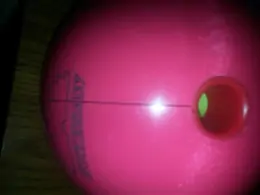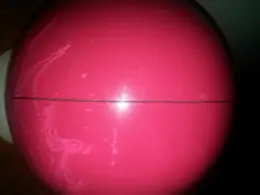Bowling Ball Education Center
What is the Pin Placement of a bowling ball?
The pin placement of a bowling ball is the distance between the center of the core and the CG.
How far the pin is from the CG will help to dictate the balls reaction on the lane. The shorter pins like (0-1") will roll up earlier on the lane, and will have a smoother arcing motion to the pocket. The longer pins like (4"+) will go much farther down the lane before starting to hook toward the pocket. The longer pins will also have a more dramatic motion toward the pins (possibly like a hockey stick shape or a skid/flip type of reaction). The 2-4" pins are the most versatile to lay out for your ball driller allowing them to manipulate the ball path and have it roll up earlier or later depending on how they lay the ball out.
Why is this important?
You want to have the bowling balls natural intended reaction to match up with your drilling pattern you select for the bowling ball. If you get a short pin but want the ball to go long the ball will want to roll up early, even if you drill the ball to go long. This will cause you to have to loft the ball or push through it harder to try to get the desired ball reaction. If you would have selected the correct pin distance and applied a complementary drilling to the ball, you can throw the ball with much less effort, and let the ball do the work for you. This allows you to relax and be smooth, improving your release and scores.
What is the Top Weight of a bowling ball?
Top weight is the amount of weight difference from the top of the bowling ball (CG) and the bottom of the ball (opposite the cg).
In general their will always be more weight to the top of the ball (CG). This is due to the fact that when you drill finger holes into the ball you are extracting weight from the ball (generally 2 ounces or more depending the hole sizes and the density of the core) and it was initially designed to keep the ball balanced after it was drilled.
Balls with lower initial top weight were generally more stable after drilled than those with higher top weights due to the fact that their was so much weight left over after drilling. This created imbalance and often time added length and backend reaction for early three piece (Pancake weight block) bowling balls.
Top weight by today's standards is not nearly as important because a majority of the weight mass of most bowling balls is closer to the center of the ball than the shell and top weight has less of an effect because ball motion is more about the placement of the weight block itself and not the static weight mass. Top weight these days usually dictates hole size for those off label drilling's.
What does this mean in selecting the correct top weight?
2.5 or less - Is for standard drilling techniques. It is also used for advanced drilling's where moving the cg further off center of span creates a stronger drilling. You may not needing a weight hole with this type of drilling but depending on how far the cg is moved you may need a weight hole.
2.5 to 3.5 - Is great for normal layouts, a weight hole is not typical for this top weight. Stronger drilling's may require a weight hole.
3.5 or more - This top weight is good if you want the ball to push more (go farther down the lane) while adding backend motion, but only if the ball driller knows and incorporates this into the drilling.
It can also be used for placing a big weight hole in a ball because it adds static weight to the drilling. This means you can use a stronger drilling than normal but make it legal by adding a weight hole to remove excess top weight (you can only have 1 oz of top weight remaining after drilling).
***NOTE: These are just basic descriptions to what top weight can do. There are many more scenarios for each top weight and what is capable with each different top weight range. Please discuss with your ball driller how they plan to drill you ball to get a better idea if they plan to use a weight hole or not to achieve the ball reaction you desire. There is no way to guarantee a ball will not need a weight hole depending on the top weight selected, the ball layout will determine that.
How To Keep Your New Ball Reacting Strong
We strongly believe that preventative maintenance is the key to a cover's longevity.
WHY? The balls ability to absorb lane oil into the pores helps to keep a dry ball surface in contact with the lane for more friction, creating added hook. Over a period of time, the bowling ball's performance will slowly deteriorate due to oil absorption and dirt build up on the ball's surface.
In addition to using a clean and dry Storm microfiber towel in competition, we highly recommend that a bowling ball cleaner be used immediately afterward to further clean the ball's cover. If a ball is used and then put away without cleaning, the oil and dirt will have a greater chance to be absorbed deeper into the cover.
We hear time and time again from people who have lost hook in their equipment and swear they clean it on a regular basis. Only when the question is asked about when they clean their equipment does the real problem come to light; cleaning a ball just before use removes only a very fine layer while the deeper trapped oil and dirt still remain from your last session. Below is our recommended procedure to maintain your ball's performance:
1. Use a clean, dry Storm microfiber towel during competition
2. At the end of the session, use Storm Reacta Clean and spray liberally over the entire surface of the ball
3. Rub your hands over the surface of the ball in a scrubbing motion for 15-20 seconds
4. Towel off the ball until dry
This process will assist the degreasing agent in the cleaner to draw oil and dirt out of the pores; the hand-action helps break down the oil and dirt, making it easier to be removed with a towel.
Bowling Ball Maintenance Checklist
| When | Polished Balls | Dull Balls |
|---|---|---|
| Between Shots | Wipe with Storm Microfiber Towel | Wipe with Storm Microfiber Towel |
| After Bowling | Clean with Storm Reacta Clean | Clean with Storm Reacta Clean |
| Every 10 Games | Re-Polish surface with Storm Reacta Shine | Scuff surface with Abralon pad to maintain original reaction |
| Every 30 Games | Scuff surface with Abralon and re-polish with Storm Reacta Shine | |
| Every 60 Games | Due for full resurface process | Due for full resurface process |
Why Do Bowling Balls Crack
Bowling balls crack for a few different reasons some are preventable and some aren't. We will briefly discuss them so you avoid the ways that are preventable.
1. Manufacture Defects (Not Preventable) - This happens from time to time and no one is really sure why bowling balls crack naturally. This is why the manufactures offer a warranty to stand behind their products. Most balls are guaranteed for 1 year, DV8 offers a 2 year warranty on their balls and Hammer offers either a 1 or 3 year warranty on their balls.
One way to tell if it is a manufacture defect is if the crack in the bowling ball is jagged (not smooth) and the crack makes turns on the ball (like a 90 degree turn).
2. Temperature Changes (Preventable) - This happens because a bowling balls coverstock expands slightly in hot temperatures and contracts in cold temperatures. When the coverstock goes through this process over and over again the coverstock becomes weaker more brittle and the ball may crack. Also, an easy way to crack your ball is the bowl with a cold bowling ball that has been sitting in your car or garage, balls should be room temperature when bowling.
One way to tell if it is a temperature change crack is if the crack in the bowling ball is smooth and goes around most if not all of the ball. Most of the time the crack will originate from a finger or thumb hole. As Seen Below
Ultimately it is totally possible for a bowling ball which has been in a temperature change situation to compound with a manufacture issue to create a crack that may be smooth, jagged or a little of both.
For this reason you should never leave your bowling balls in your car, in front of a window, on a heat vent, or on a floor (with a concrete slab below). A good place to keep your balls are: in a closet, on a shelf or something slightly elevating them, in a roller bag, or in a temperature controlled room.


This is a example of a temperature crack, it starts at the thumb and goes all the way around to the fingers.
Bowling & Bowling Ball Technical Videos
We have added informational videos produced by the pros at Storm Bowling to our site. These videos cover a wide variety of topics from how to bowl, oil patterns, bowling ball construction, and drilling techniques/ball layouts. These videos will help to improve your bowling game, so take some advise from the pro bowlers who have seen and been through it all.
Here at CheapBowlingBalls.com we aim to educate our customers so they can select the best bowling products possible. Helping to improve their scores and their love for the game at the same time.
Login and Registration Form